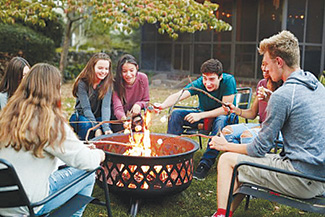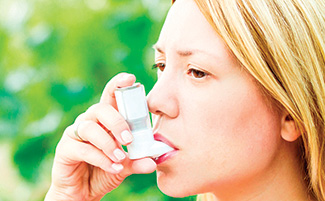 Fire pits are very popular. What’s better for making s’mores? If you’re planning to gather friends or family around a crackling bonfire or cozy fire pit, make sure to just absorb the atmosphere — not the smoke.
Fire pits are very popular. What’s better for making s’mores? If you’re planning to gather friends or family around a crackling bonfire or cozy fire pit, make sure to just absorb the atmosphere — not the smoke.
You’ve likely experienced the results before — stinging eyes, runny nose and coughing. These symptoms are short-lived for most people. But for those with underlying respiratory illnesses, inhaling smoke is dangerous, warns Cleveland Clinic in a recent article. Wood smoke contains millions of tiny particles. When you breathe in smoke, the particles can get deep into your respiratory system.
Here’s how to protect your lungs and make your next fire safer:
BREATHING IN SMOKE
Most people can enjoy an outdoor fire safely by not sitting too close and not breathing in the smoke. But it’s a different story for the nearly 40 million Americans with asthma or chronic obstructive pulmonary disease (COPD), including emphysema.
If you have an underlying respiratory disease, inhaling smoke from wood, even briefly, can cause a chain of airway tightening that can land you in the emergency room. If you have asthma or COPD, take extra precautions. Sit as far from the fire as possible, and pay attention to which way the wind is blowing at all times.
Smoke isn’t the only health hazard you should avoid. The heat itself is harmful. Inhaling air that is consistently at a higher temperature than the surrounding air can cause more damage to the lining of your lower respiratory tract than smoke inhalation. If you feel intense heat on your hands or face, that’s a clear signal that the air you’re breathing is too hot and you should move back from the fire.
Alleviate summer breathing problems
Air quality affects respiratory health, especially for those who suffer from asthma, chronic obstructive pulmonary disease (COPD), and other chronic lung diseases. If you have trouble breathing in the summer months, here are eight steps you can take to help you breathe easier.
1. Avoid peak heat. Avoid spending extended periods of time outside between 11 a.m. and 4 p.m. During the hottest part of the day, pollutants are typically at their worst. Also, avoid exercising outdoors during this time.
2. Avoid pollutants. Monitor the air quality index on a daily basis. This information is reported on the local news as well as posted online. A color-coded system makes it easy to follow.
3. Remain in a cool environment whenever possible. It is easier to breathe in cooler temperatures. However, your indoor environment can aggravate symptoms as well, so keep your home clean to minimize dust and mold exposure, and vacuum often with a high-efficiency particulate arrestance (HEPA) filter, especially if you have pets.
 4. Wear a mask. Wear a filtration mask while you garden, mow the lawn or clean indoors. These masks help filter out pollutants and dust particles that aggravate lungs.
4. Wear a mask. Wear a filtration mask while you garden, mow the lawn or clean indoors. These masks help filter out pollutants and dust particles that aggravate lungs.
5. Maintain air filters. Air and vacuum filters should be changed regularly to ensure they are filtering at their maximum capacities. This is especially important for pet owners because pet dander can circulate through air conditioning units and build up in vacuum filters.
6. Keep bedrooms off-limits to pets. You spend a large chunk of your day in your bed sleeping, so limit allergen exposure by keeping your furry friend out of the bedroom.
7. Stay well-hydrated. Drink plenty of fluids throughout the day to reduce the thickness of mucus in your passageways. This allows air to flow more freely.
8. Understand your triggers. First and foremost, it is important to know your triggers and understand when, where and how they present.
Safety tips for building a fire
Here are seven tips for building safer fires outdoors:
1. Use only untreated wood. It’s best to use wood that has been well-seasoned (for six months to a year) and kept dry. This can reduce the amount of smoke your fire produces. Pressure-treated lumber, railroad ties and wood from construction sites can contain toxic chemicals such as arsenic and aren’t safe to burn.
2. Play it safe with manufactured logs. Manufactured logs are typically made of sawdust and wax or similar materials. They may produce less smoke than traditional firewood, but that doesn’t make the smoke any safer. They can contain many ingredients and it’s impossible to predict how your lungs will react. Also, if you plan to cook anything over a fire of manufactured logs, find a brand approved for cooking (since most aren’t).
3. Choose a calm day. If winds are blowing at more than 20 miles per hour, it’s probably a good idea to build your fire another day.
4. Keep both fire and logs small. Smaller fires burn hotter, more completely and with less smoke. For best results, choose firewood that’s less than six inches in diameter.
5. Instruct children on fire safety. Children need adult guidance and close supervision around fires. Teach them to keep their distance from fires and limit their exposure to wood smoke. Their respiratory systems are still developing.
6. Don’t use gasoline or other accelerants to start your fire. Accelerants, such as gasoline, can cause fires to flare up or rage out of control quickly. They can also release toxins into the air. Opt for small sticks or cubes approved for starting fires more safely.
7. Keep a bucket of water or a hose nearby. Having a source of water near your fire will ensure that you are ready to act if the flames spread or get out of control. It’s a good idea to keep the potential for respiratory damage in mind and to protect yourself accordingly.
So don’t say goodbye to toasted marshmallows or cozy nights, follow the tips outlined above, and you’re on your way to enjoying outdoor fires safely.

